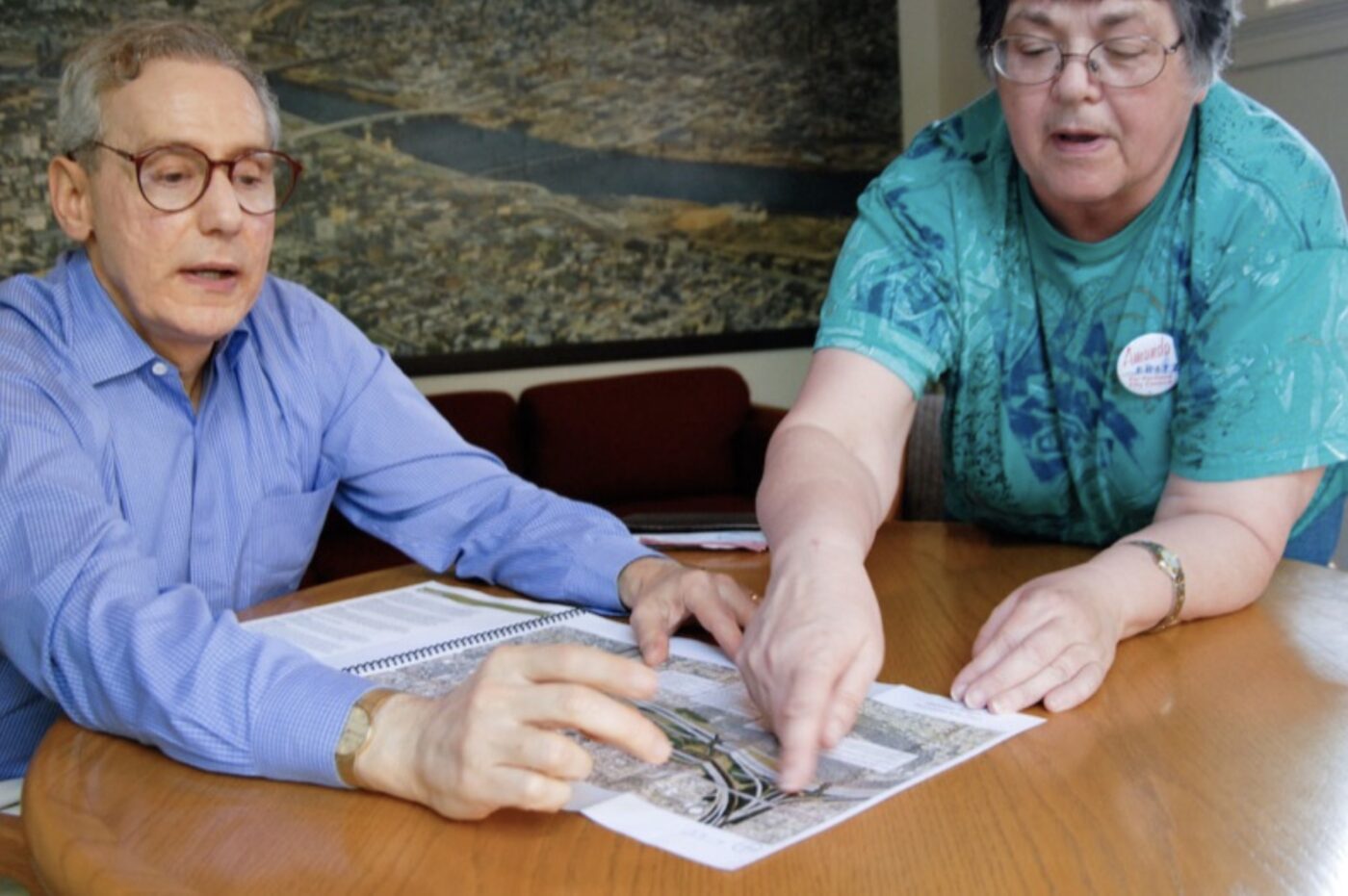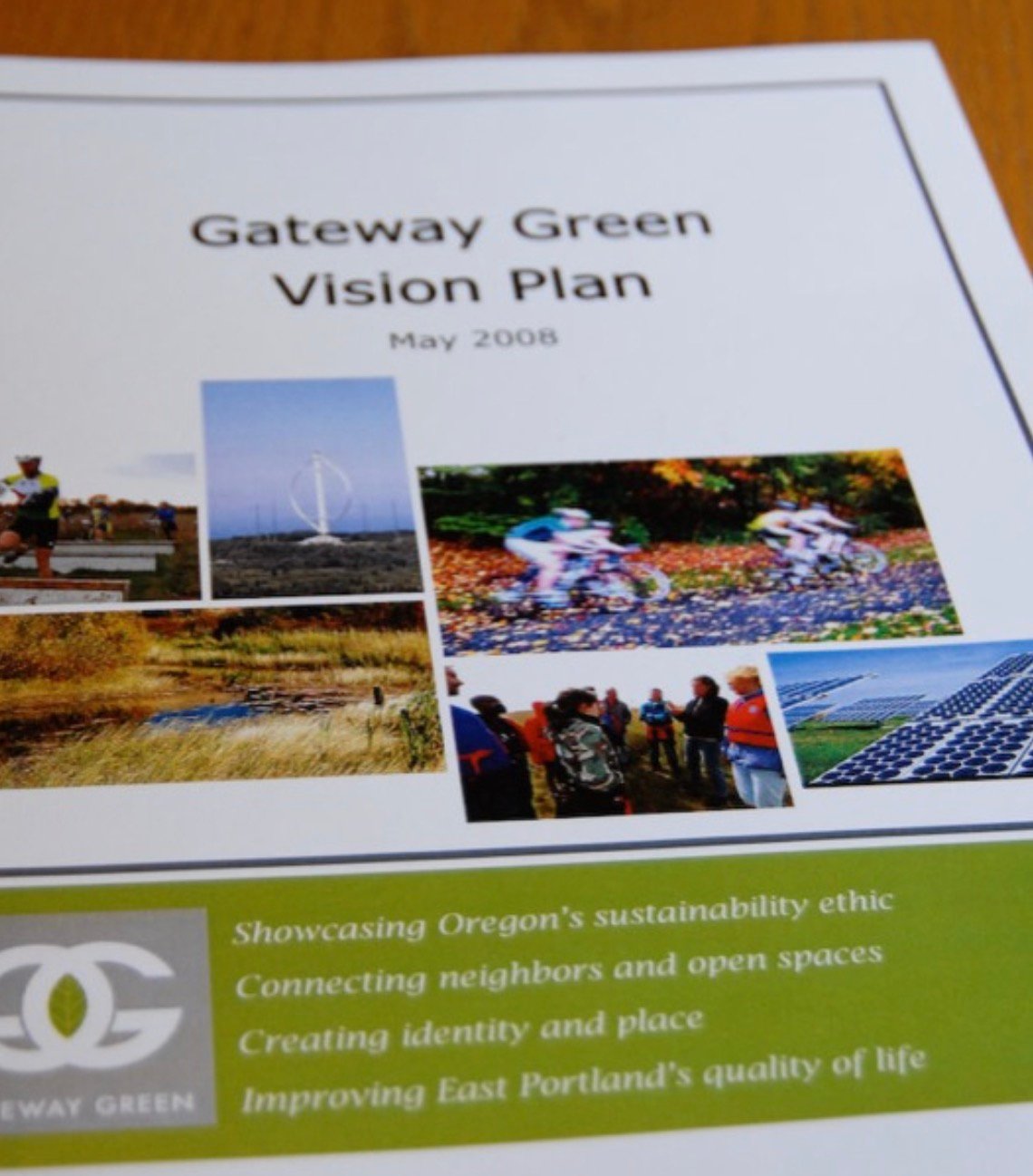
(Photos © J. Maus)
About seven miles east of downtown Portland, lies 35 acres of unused land between two interstate freeways.
Today, it’s just another anonymous, ODOT-owned parcel, but that’s about to change due to the unlikely partnership of an East Portland developer and a volunteer parks advocate. If their ambitious plans materialize, the parcel could become a hub of biking activity, a connection to nature for neighboring communities, and a catalyst for a long-awaited revitalization of East Portland.

(Graphic: BikePortland.org)
For the past two years, Gateway area developer Ted Gilbert and parks advocate Linda Robinson have quietly worked on a project known as “Gateway Green”. The idea is turn a parcel of land between I-84 and I-205 (just north of the Gateway Transit Center) into an eco-sensitive, urban oasis that would provide recreational opportunities and make a statement about Portland and Oregon’s commitment to sustainability.
Now, with the completion this week of the Gateway Green Vision Plan, the project is gaining momentum.
Bike trails (in many forms) have been a part the vision for this space since Day One, so I have been keeping tabs on this project for over a year. Yesterday, I finally got a sneak peek at the Vision Plan and I met with Gilbert and Robinson to get an update.
After many meetings with stakeholders and neighborhood groups in the past months, Gilbert said he heard plenty of great ideas about what could be done with the project. “I know it could be a lot of things. But rather than be all things to all people, I thought, let’s do just a few things very well.”
Gilbert told me he has decided to zero in on two key elements — sustainability and biking.
In addition to extensive stormwater treatment, solar panels and wind turbines, Gilbert envisions Gateway Green as a mecca for bikes.
On page 11 of the Vision Plan (which was created by David Evans & Associates and won’t be made public until next week), “Bicycling” is listed first in a chapter on design. The copy mentions that “there is currently a shortage of suitable urban venues” for the “burgeoning sports of mountain biking, cyclocross, and free-riding.”
Authors of the plan write that Gateway Green would include “a critical link in the bicycle commute network”. Gilbert adds that plans call for a new bike access ramp from NE 102nd into the site and a proposed land bridge over I-205 that would eventually connect with the (not yet built) Sullivan’s Gulch Trail.
Once the Sullivan’s Gulch Trail is built, the Vision Plan states that, “Gateway Green becomes the nexus of north-south and east-west bicycle commuting in the region.”
But the real excitement about this project is not how you can ride through it on your way to work, but the new trails inside it for the knobby-tired set.
Singletrack trails are proposed for a wooded area of the site and a “figure 8 bicycle pathway” would take mountain bikes through the entire property, and eventually over a new I-205 bridge that would connect with the existing off-road trails in Rocky Butte Park.
Gilbert enthusiastically shared his hopes that Gateway Green becomes a host site for championship-level cyclocross and free-ride events. Key to the plan is a “pump-track” and mountain bike skills course that would welcome riders of all levels to test their skills over man-made obstacles and technical trails that would take advantage of the natural topography of the site (it slopes from south to north).
NE Halsey Street passes over the site’s southern tip and has a good view of where Gilbert sees the future free-riding course. “My plan,” he says with an excited tone, “is to create viewing platforms off of Halsey so spectators can get a good view of the action.”
The vision, the parcel, and Gilbert’s commitment to the project is exciting to say the least.
According to Linda Robinson — one of Portland’s most dedicated parks advocates who has worked with Gilbert on this project for two years — the Gateway Green site is geographically perfect. She notes that East Portland in general has been labeled “open space deficient” by the Coalition for a Livable Future’s Equity Atlas project.
Robinson and Gilbert also rattle off other stats like the fact that 300,000 people live within five square miles of the site and a whopping 65 million people pass by the site each year.
Metro says that — with two freeways, a MAX line, a Transit Center, commercial centers and the airport nearby — the area around Gateway Green is projected to be the “region’s most accessible location by 2017.”
As a commercial and residential property owner in the nearby Gateway area, Gilbert does not hide the fact that much of his motivation for this project lies in its “catalytic” potential to spark a resurgence in local property values.
“We hope this becomes the branding tool that helps people take a fresh look at East Portland,” he says, “and once people are out here recreating, then they might want to move here…
“There are a lot of details to hammer out, but we’re open to it.”
— ODOT spokesperson Christine Miles
But before any grand plans become reality there are two main issues hanging over the excitement — funding and ODOT.
ODOT currently owns the parcel and has to agree to convey the land or the project is dead in the water.
To even consider handing over their parcel, ODOT has laid out several conditions: they must maintain the right-of-way needed to widen I-205 if/when necessary; they do not want to incur any additional maintenance responsibilities; they do not want any increased legal liability; the plans cannot include any new roads (or alteration of existing roads); and there can be no commercial activity within the parcel.
Gilbert and Robinson met with ODOT yesterday to share the completed Vision Plan. So far, they say, “ODOT has been very supportive” and has essentially signed off on the concepts and ideas presented in the Vision Plan. ODOT has made no commitments to the project yet but Gilbert seems hopeful. “We’ve got several hurdles to jump still…but it should be doable.”
That sentiment is echoed by ODOT spokesperson Christine Miles. She says they’re excited about the project but that, “This is just the first phase. There are a lot of details to hammer out, but we’re open to it.”
The other major step for the project is of course how to pay for it all.
According to the Vision Plan, the “total package” is approximately $20.5 million — but Gilbert is quick to point out that that number includes over $18 million in new bridges and high-tech “green” elements like wind turbines and solar-powered art work.
For much less money, planners have estimated that a “phase one” package — which would include all the site furnishings, tree plantings, signage, and bike paths — could be done for only $2.3 million. Add one new I-205 overpass that would extend the existing pedestrian/bike bridge near Maywood Park and the cost is still only $3.8 million.
The next task for Gilbert is to drum up community support and bend the ear of potential private investors. He says he’s already got one generous commitment; “If we can guarantee a world-class facility, I have a private donor who will give us $1 million.”
Other funding sources might be Metro’s Nature in Neighborhoods program, which was carved out of their $260 million Natural Areas Bond Measure which was passed by voters in 2006.
Gilbert, who has become known for his commitment to “green” development in other projects, says he also hopes Gateway Green will inspire others. “If we can transform this space, there’s a lot of other land like this around the region…it could be an example.”
Community support will be a key factor in both getting ODOT to relinquish the land and to acquiring funding sources. On Thursday, Gilbert and Robinson will present the new Vision Plan to a group of stakeholders and a public bike ride/rally is likely to be planned at the site later in the summer.
Stay tuned for opportunities to get involved.




